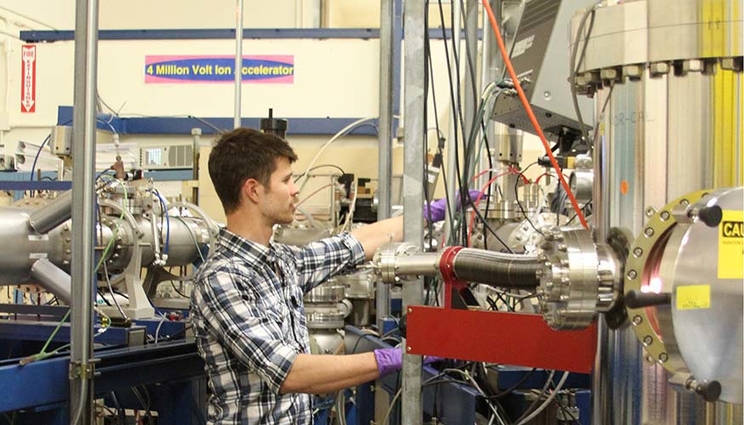Lab pulsed-ion beam experiments reveal radiation damage processes in silicon
 (Download Image)
Lawrence Livermore scientist Joseph Wallace adjusts the microbeam aperture on the Rutherford backscattering spectrometry system, which is used to characterize radiation damage as a function of depth in the samples.
(Download Image)
Lawrence Livermore scientist Joseph Wallace adjusts the microbeam aperture on the Rutherford backscattering spectrometry system, which is used to characterize radiation damage as a function of depth in the samples.
Materials scientists at Lawrence Livermore National Laboratory (LLNL) have used a novel pulsed-ion-beam method to identify mechanisms of radiation defect formation in silicon.
The research could have implications for improvements in modern electronics performance.
Understanding radiation defects in crystals has been a major materials physics challenge for decades. Stable defect formation often involves dynamic processes of migration and interaction of point defects generated by energetic particles. The exact pathways of defect formation, however, have remained elusive, and most current predictions of radiation damage are essentially empirical fits to experimental data. This applies even to the best studied and arguably simplest material, crystalline silicon, which is the backbone of modern electronics. Until recently, scientists lacked experimental methods that could directly probe the dynamics of defect creation and annealing.
In an article published in the Jan. 6 edition of Scientific Reports, the team from LLNL and Texas A&M University used a novel experimental method to study thermally activated defect interaction processes in silicon. The method exploits pulsed, rather than continuous, ion beams capable of probing defect interaction dynamics. By measuring temperature dependencies of the dynamic annealing rate of defects, the team found two distinct regimes of defect interaction, at temperatures above and below 60 degrees Celsius, respectively.
The rate theory modeling, benchmarked against pulsed-beam data, pointed to a crucial role of both vacancy and interstitial diffusion, with the defect production rate limited by the migration and interaction of vacancies.
"Direct measurements of the activation energies of the dominant dynamic annealing processes is key to understanding the formation of stable radiation damage in materials," said LLNL scientist Joseph Wallace, the lead author of the paper.
"This work provides a blueprint for future pulsed-beam studies of radiation defect dynamics in other technologically relevant materials," said Sergei Kucheyev, the LLNL project lead.
This research was funded by the Nuclear Energy Enabling Technologies (NEET) Program of the Department of Energy, Office of Nuclear Energy. The other researchers contributing to this work are L. Bimo Bayu Aji, Swanee Shin and Alden Martin from LLNL and Lin Shao from Texas A&M University.
Contact
 Anne M. Stark
Anne M. Stark
[email protected]
(925) 422-9799
Related Links
Scientific ReportsLab team uses pulsed ion beams to probe radiation defect dynamics in nuclear materials
Tags
Physical and Life SciencesFeatured Articles







